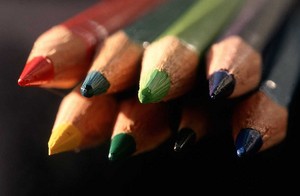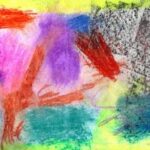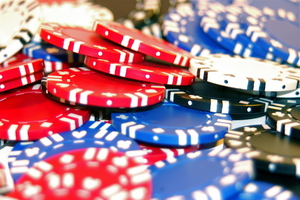More and more lately, I’m coming to see just how much I crave visual stimulation. It is inspiring, often surprising, the things that one can learn just by really looking. I’m seeing that when I take the time to add a visual spark to whatever I’m doing, I’m much more motivated to get it done.
Partly, it’s the act of creating. Using nothing more than my hands and my imagination, I get to bring to life something the world has never seen before. Because it came from my imagination. It is a thing that makes me feel more connected, more complete, a wholer, richer person in myself. I think that’s probably how most artists and crafters feel. Creating something that can be seen, that can be felt, is like adding a dimension to reality that was never there before.
Thinking all these things, and combining them with the writing I stubbornly do every single day (even days when I’d really much rather curl up with a good book and peruse someone else’s writing), I stumbled across a concept that’s really not so new but wasn’t something I’d given much thought to before: the visual journal.
Visual journals, or art journals, are an amazing mixture of words and images that can convey raw emotion much more effectively than a naked page. They provide a chance for you to access a different area of your creative brain, going beyond words, making your journal a source of inspiration, a place where you can go play and express your deepest joys and darkest sorrows.
Art Journal How-To
Words can only express so much. We can describe with all our heart, but the old saying that a picture is worth a thousand words is too often true. When we combine images with words, we can come to a deeper understanding of ourselves and the world around us in ways that writing alone can’t touch.
Think of the art journal as a way of illuminating your words and in turn illuminating yourself.
1. Start With a Blank: You can begin your art journal in a variety of ways. Purchase a blank journal that catches your eye, or get a stack of paper you really like the feel of and prepare to make your own.
The first option is, of course, the easiest. All that you need is a bound book that has lots and lots of blank pages. You don’t want lined pages – the only place you want any ink (if even there) is on the covers. This can take the form of a sketchbook, a traditional leather-bound journal, or a blank cover book that is intended for you to cover yourself.
The second option appeals to people who really, really obsess on creation (like me). This option will take more work later on, but can reward you with something that is yours from start-to-finish. You’ll want to start with a ream of quality paper (get something better than printer paper, if you can afford it) and a box to keep both the paper and your journaled pages free from dust. Don’t worry about the covers yet – just start using your papers as individual journal canvas pages.
2. Begin Your Art: The way of actually creating journal art is as varied as the artist. Every single person who keeps a visual journal uses a different process.
Teesha Moore (www.teeshamoore.com) is probably one of the most in-depth visual journalists out there – and her work shows it. She begins with a layer of watercolor, which she then collages on top of. The next layer is all about artist crayons, and the fourth layer uses her pens and pencils to doodle, write, and add details to the collages. And she’s usually not done. She will decorate her pages to the point that she’s happy with them, then takes them with her to the coffee shop or bookstore to actually write in them.
If there’s a “trick”, it’s this: use your life in your art. Someone who absolutely loves to sew might find some interesting art by incorporating pieces of fabric in their collage. I created a page once that has been carefully pasted to a visual journal page while I was waitressing. The “page” started as a simple paper napkin, which I freestyled a poem on. Then, I carefully singed all the edges of the napkin with a lighter to really enhance the effect (it was a dark, dark poem). This little piece has been carried with me through years and now forms a part of my visual journal, something that reminds me where I’ve come from to get where I am now.
4. Make it a Habit: Just like any journaling, a visual journal gets easier to do and more powerful when you make it a habit that you do on a daily basis. Find a time of the day that you’re pretty introspective and will probably have some time to yourself. For me, that time of day is in the evening right after I’ve put my daughter to bed. I have a whole day’s worth of thoughts tumbling around in my mind, and being able to kick back with my art journal pages is like a meditative treat, letting me work out my joys and frustrations in a form that I can see come to life.
5. Make it Yours: When your journal is filled (if you’re using a purchased, bound one), you’ll want to finish it off by accenting the covers, dating the inside cover with the start and end dates, or anything else that feels to you like a stamp of approval. It’s your way of saying, “Look at this. I did it, it’s mine, and now I’m ready to move on to something new.”
If you decided to go the whole “make it myself” direction, this step is actually easier in some ways. Sure, you’ll have to spend more time on it to get your piece put together, but it will be “yours” from the get-go. There are tons of hand-binding tutorials on the Internet for you to choose from, but here are a couple that I’ve found to be the most complete and useful:
http://www.teeshamoore.com/how_to_make_journals.htm
http://www.instructables.com/id/EIMMKLGI5QES9J555I/









